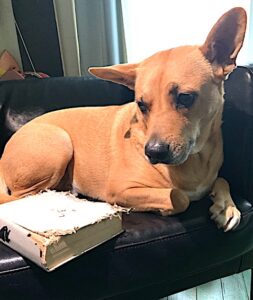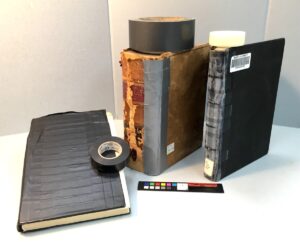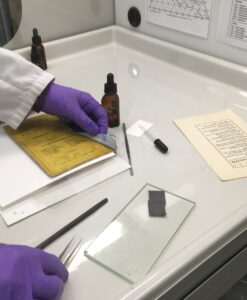“The dog ate my homework.” It really happens! Dogs and cats also occasionally eat books . . . or at least gnaw on them. Well-intentioned library patrons and book collectors sometimes attempt repair of pet and other damage to books with the most immediate solution at home: pressure-sensitive tapes such as magic, electrical, and duck (or duct). These repairs tend to be meticulously thorough – layer upon layer and extra-wide strips of pressure-sensitive tape applied to re-attach covers and fill out chewed-away corners. The Emory Libraries conservators have seen it all!
While expedient and sturdy (but not so attractive) in the short term, tape repairs ultimately cause even more damage in the long term and require expert, time-consuming treatment by book and paper conservators. A standard estimate is that it takes a trained conservator about an hour per inch to remove tape and tape staining.
Treatment begins with spot testing and other analysis to determine the type of tape and its components (carrier, adhesive, and other chemical and pigment additives), as well as the properties of material to which it has been applied. Remediation techniques may include dry, mechanical removal with hand tools, heat or aqueous methods, or the application of complex solvent combinations targeting specific adhesives. Some adhesives, as in duct or duck tape, are proprietary and not disclosed in the manufacturer’s Safety Data sheets and so require even lengthier experimentation. All of this additionally requires specialized conservation equipment, such as a suction table, fume hood, deionized water system, and of course, personal protective equipment. Conservation staff reserve this kind of complex treatment for rare and unique special collections materials.
So what should you do if your puppy eats your library book? Honesty is the best policy. Return it as is, and our conservation team, including conservation student assistants, may be able to perform a much simpler and effective repair.
This post is dedicated to our late friend and colleague, Lloyd Busch, who helped with my research on duct tape for another project several years ago. At my initial reference desk consultation, Lloyd provided many leads to promising resources. Then for weeks, he continued to explore and read further articles on the history and composition of duct tape. He not only shared those additional resources but took the time to point out particularly interesting passages. Lloyd will be greatly missed.
For more information on tape removal, please visit this link to the American Institute for Conservation – Book and Paper Group Wiki.
– Julie Newton, assistant conservator, Emory Libraries Conservation Lab




